Advanced Time-Frequency Methods for ECG Waves Recognition
Abstract
:1. Introduction
2. Literature Review
3. Materials and Methods
3.1. Dataset
3.2. ECG Preprocessing and Segmentation
3.3. Time-Frequency Representations
3.3.1. Irisgram ECG Representation
3.3.2. Scalogram ECG Representation
3.4. Deep Learning
4. Results
4.1. Irisgram Representation
4.1.1. ResNet
4.1.2. ShuffleNet
4.2. Scalogram Representation
4.2.1. ResNet
4.2.2. ShuffleNet
4.3. K-Fold Results
5. Conclusions
Author Contributions
Funding
Institutional Review Board Statement
Informed Consent Statement
Data Availability Statement
Conflicts of Interest
References
- Spach, M.S.; Kootsey, J.M. The nature of electrical propagation in cardiac muscle. Am. J. Physiol.-Heart Circ. Physiol. 1983, 244, H3–H22. [Google Scholar] [CrossRef]
- Luz, E.J.D.S.; Schwartz, W.R.; Cámara-Chávez, G.; Menotti, D. ECG-based heartbeat classification for arrhythmia detection: A survey. Comput. Methods Programs Biomed. 2016, 127, 144–164. [Google Scholar] [CrossRef]
- Barros, A.; Resque, P.; Almeida, J.; Mota, R.; Oliveira, H.; Rosário, D.; Cerqueira, E. Data improvement model based on ECG biometric for user authentication and identification. Sensors 2020, 20, 2920. [Google Scholar] [CrossRef] [PubMed]
- Al-Ani, M.S. ECG waveform classification based on P-QRS-T wave recognition. UHD J. Sci. Technol. 2018, 2, 7–14. [Google Scholar] [CrossRef] [Green Version]
- Klabunde, R.E. Cardiac electrophysiology: Normal and ischemic ionic currents and the ECG. Adv. Physiol. Educ. 2017, 41, 29–37. [Google Scholar] [CrossRef] [PubMed] [Green Version]
- Tereshchenko, L.G.; Josephson, M.E. Frequency Content and Characteristics of Ventricular Conduction. J. Electrocardiol. 2015, 48, 933–937. [Google Scholar] [CrossRef] [Green Version]
- Sanamdikar, S.T.; Hamde, S.T.; Asutkar, V.G. A literature review on arrhythmia analysis of ECG signal. Int. Res. J. Eng. Technol. 2015, 2, 307–312. [Google Scholar]
- Rashed-Al-Mahfuz, M.; Moni, M.A.; Lio, P.; Islam, S.M.S.; Berkovsky, S.; Khushi, M.; Quinn, J.M. Deep convolutional neural networks based on ECG beats classification to diagnose cardiovascular conditions. Biomed. Eng. Lett. 2021, 11, 147–162. [Google Scholar] [CrossRef]
- Swain, S.S.; Patra, D.; Singh, Y.O. Automated detection of myocardial infarction in ECG using modified Stockwell transform and phase distribution pattern from time-frequency analysis. Biocybern. Biomed. Eng. 2020, 40, 1174–1189. [Google Scholar] [CrossRef]
- Lekhal, R.; Zidelmal, Z.; Ould-Abdesslam, D. Optimized time–frequency features and semi-supervised SVM to heartbeat classification. Signal Image Video Process. 2020, 14, 1471–1478. [Google Scholar] [CrossRef]
- Kayikcioglu, I.; Akdeniz, F.; Köse, C.; Kayikcioglu, T. Time-frequency approach to ECG classification of myocardial infarction. Comput. Electr. Eng. 2020, 84, 106621. [Google Scholar] [CrossRef]
- Kłosowski, G.; Rymarczyk, T.; Wójcik, D.; Skowron, S.; Cieplak, T.; Adamkiewicz, P. The use of time-frequency moments as inputs of lstm network for ecg signal classification. Electronics 2020, 9, 1452. [Google Scholar] [CrossRef]
- Wang, T.; Lu, C.; Sun, Y.; Yang, M.; Liu, C.; Ou, C. Automatic ECG classification using continuous wavelet transform and convolutional neural network. Entropy 2021, 23, 119. [Google Scholar] [CrossRef]
- Hussein, A.F.; Hashim, S.J.; Rokhani, F.Z.; Wan Adnan, W.A. An automated high-accuracy detection scheme for myocardial ischemia based on multi-lead long-interval ECG and Choi-Williams time-frequency analysis incorporating a multi-class SVM classifier. Sensors 2021, 21, 2311. [Google Scholar] [CrossRef] [PubMed]
- Alqudah, A.M.; Alqudah, A. Deep learning for single-lead ECG beat arrhythmia-type detection using novel iris spectrogram representation. Soft Comput. 2022, 26, 1123–1139. [Google Scholar] [CrossRef]
- Farag, M.M. A Self-Contained STFT CNN for ECG Classification and Arrhythmia Detection at the Edge. IEEE Access 2022, 10, 94469–94486. [Google Scholar] [CrossRef]
- “ECG-ID Database v1.0.0.” ECG-ID Database v1.0.0. Available online: www.physionet.org/content/ecgiddb/1.0.0 (accessed on 19 November 2022).
- “PhysioNet/CinC Challenge 2015: Training Sets.” PhysioNet/CinC Challenge 2015: Training Sets. Available online: archive.physionet.org/physiobank/database/challenge/2015 (accessed on 19 November 2022).
- Berkaya, S.K.; Uysal, A.K.; Gunal, E.S.; Ergin, S.; Gunal, S.; Gulmezoglu, M.B. A survey on ECG analysis. Biomed. Signal Process. Control. 2018, 43, 216–235. [Google Scholar] [CrossRef]
- Wahabi, S.; Pouryayevali, S.; Hari, S.; Hatzinakos, D. On evaluating ECG biometric systems: Session-dependence and body posture. IEEE Trans. Inf. Secur. 2014, 9, 2002–2013. [Google Scholar] [CrossRef]
- Kamath, C. ECG beat classification using features extracted from Teager energy functions in time and frequency domains. IET Signal Process. 2011, 5, 575–581. [Google Scholar] [CrossRef]
- Ebrahimpour, R.; Sadeghnejad, N.; Sajedin, A.; Mohammadi, N. Electrocardiogram beat classification via coupled boosting by filtering and preloaded mixture of experts. Neural Comput. Appl. 2013, 23, 1169–1178. [Google Scholar] [CrossRef]
- Rai, H.M.; Trivedi, A.; Shukla, S. ECG signal processing for abnormalities detection using multi-resolution wavelet transform and Artificial Neural Network classifier. Measurement 2013, 46, 3238–3246. [Google Scholar] [CrossRef]
- Donoso, F.I.; Figueroa, R.L.; Lecannelier, E.A.; Pino, E.J.; Rojas, A.J. Atrial activity selection for atrial fibrillation ECG recordings. Comput. Biol. Med. 2013, 43, 1628–1636. [Google Scholar] [CrossRef] [PubMed]
- Chaitanya, N.K.; Radhakrishnan, A.; Reddy, G.R.; Manikandan, M.S. A simple and robust QRS detection algorithm for wireless medical body area network. In Proceedings of the 2011 International Conference on Emerging Trends in Networks and Computer Communications (ETNCC), Udaipur, India, 22–24 April 2011; pp. 153–158. [Google Scholar]
- Jones, D.L.; Touvannas, J.S.; Lander, P.; Albert, D.E. Advanced time-frequency methods for signal-averaged ECG analysis. J. Electrocardiol. 1992, 25, 188–194. [Google Scholar] [CrossRef] [PubMed]
- Zhivomirov, H. A novel visual representation of the signals in the time-frequency domain. UPB Sci. Bull. Ser. C Electr. Eng. Comput. Sci. 2018, 80, 75–84. [Google Scholar]
- Gentry, C.; Liao, C.T.; You, W.; Ryan, S.A.; Varner, B.A.; Shi, X.; Cating-Subramanian, E. Super-resolved time–frequency measurements of coupled phonon dynamics in a, 2D quantum material. Sci. Rep. 2022, 12, 1–8. [Google Scholar] [CrossRef] [PubMed]
- “Digital Signal Processing System Design.” Digital Signal Processing System Design|ScienceDirect. Available online: www.sciencedirect.com:5070/book/9780123744906/digital-signal-processing-system-design (accessed on 30 November 2022).
- Byeon, Y.H.; Pan, S.B.; Kwak, K.C. Intelligent deep models based on scalograms of electrocardiogram signals for biometrics. Sensors 2019, 19, 935. [Google Scholar] [CrossRef] [PubMed] [Green Version]
- Analysis Mathematical Physics by Triebel—AbeBooks. Available online: https://www.abebooks.com/book-search/title/analysis-mathematiCal-physics/Author/Triebel/ (accessed on 29 November 2022).
- “Spectrogram Visualization with Matlab.” Spectrogram Visualization with Matlab–File Exchange—MATLAB Central. Available online: www.mathworks.com/matlabcentral/fileexchange/64882-spectrogram-visualization-with-matlab (accessed on 3 December 2018).
- Ren, Z.; Qian, K.; Zhang, Z.; Pandit, V.; Baird, A.; Schuller, B. Deep scalogram representations for acoustic scene classification. IEEE/CAA J. Autom. Sin. 2018, 5, 662–669. [Google Scholar] [CrossRef]
- Mourad, K.; Fethi, B.R. Efficient automatic detection of QRS complexes in ECG signal based on reverse biorthogonal wavelet decomposition and nonlinear filtering. Measurement 2016, 94, 663–670. [Google Scholar] [CrossRef]
- Lee, J.N.; Kwak, K.C. Personal identification using a robust eigen ECG network based on time-frequency representations of ECG signals. IEEE Access 2019, 7, 48392–48404. [Google Scholar] [CrossRef]
- Alquran, H.; Alsalatie, M.; Mustafa, W.A.; Abdi, R.A.; Ismail, A.R. Cervical Net: A Novel Cervical Cancer Classification Using Feature Fusion. Bioengineering 2022, 9, 578. [Google Scholar] [CrossRef]
- Alquran, H.; Al-Issa, Y.; Alsalatie, M.; Mustafa, W.A.; Qasmieh, I.A.; Zyout, A. Intelligent Diagnosis and Classification of Keratitis. Diagnostics 2022, 12, 1344. [Google Scholar] [CrossRef] [PubMed]
- Alawneh, K.; Alquran, H.; Alsalatie, M.; Mustafa, W.A.; Al-Issa, Y.; Alqudah, A.; Badarneh, A. LiverNet: Diagnosis of Liver Tumors in Human CT Images. Appl. Sci. 2022, 12, 5501. [Google Scholar] [CrossRef]


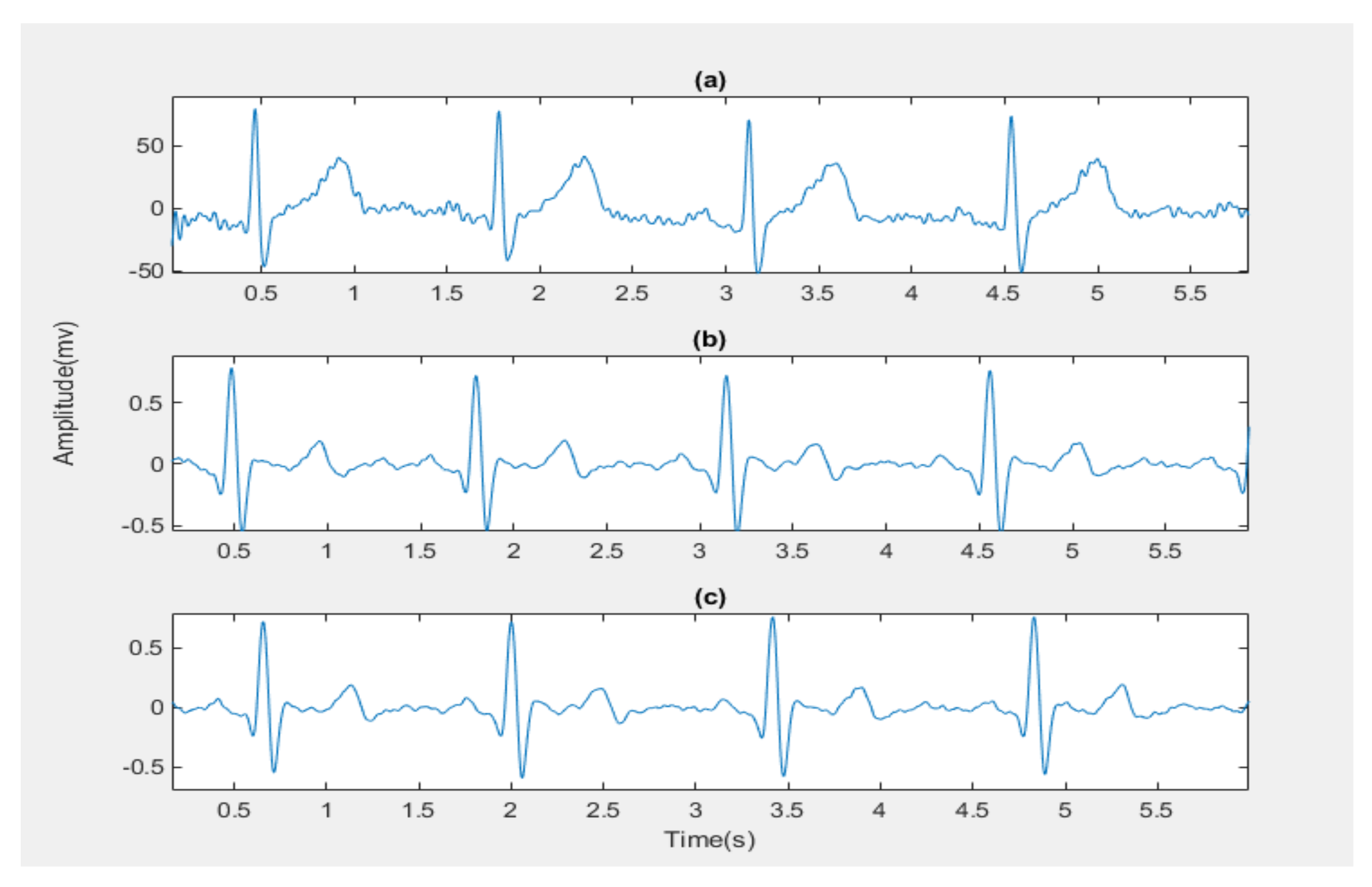
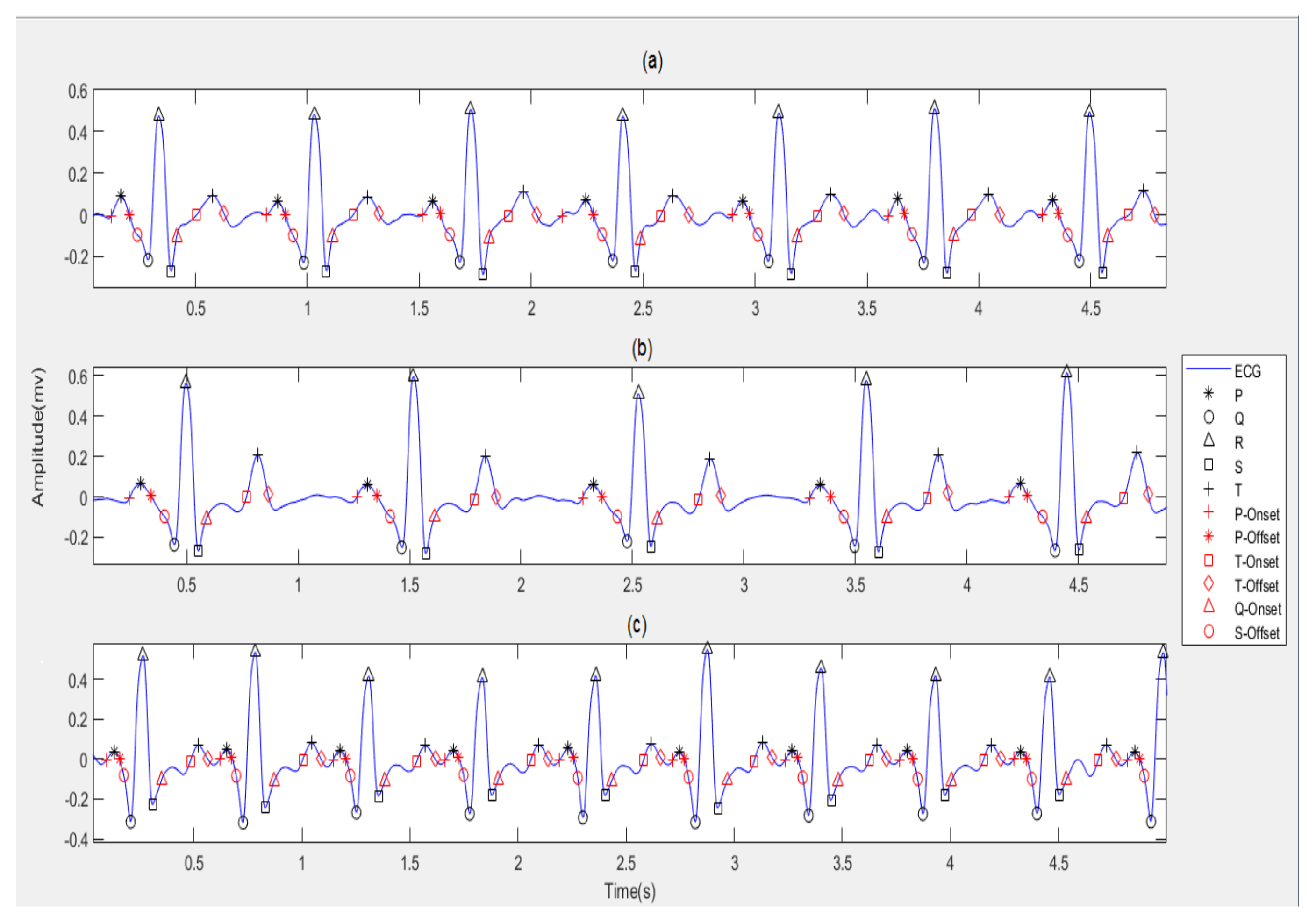
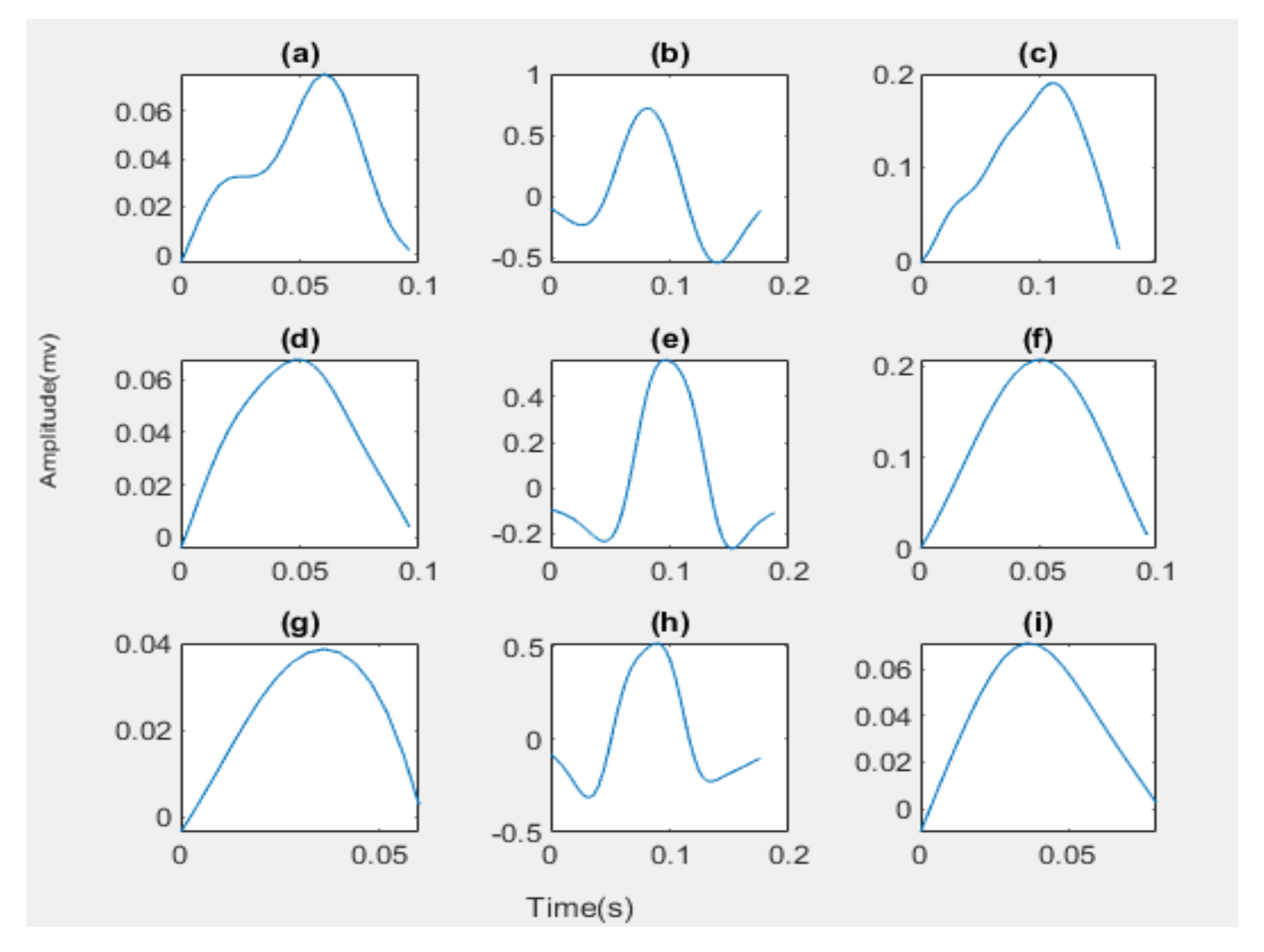

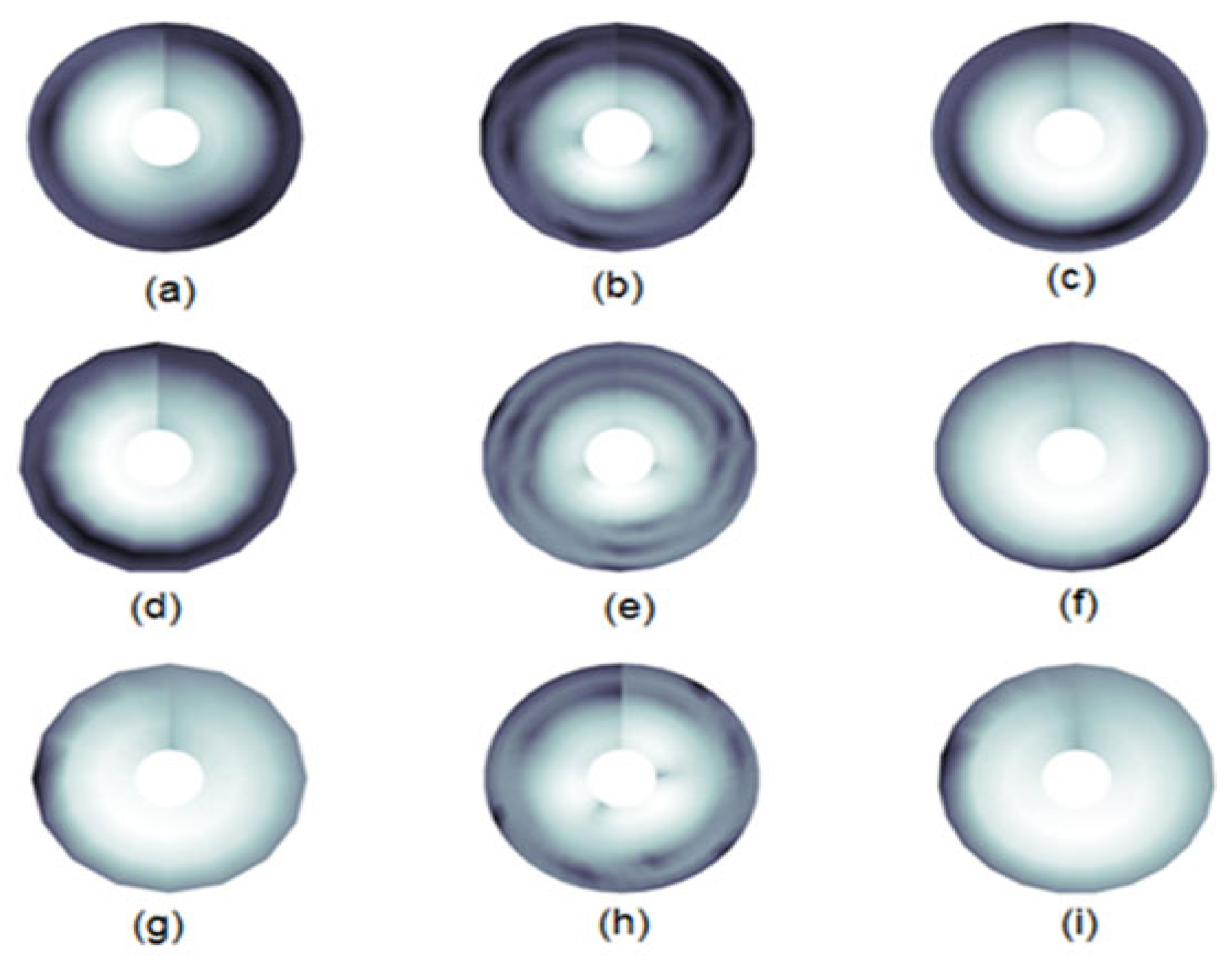

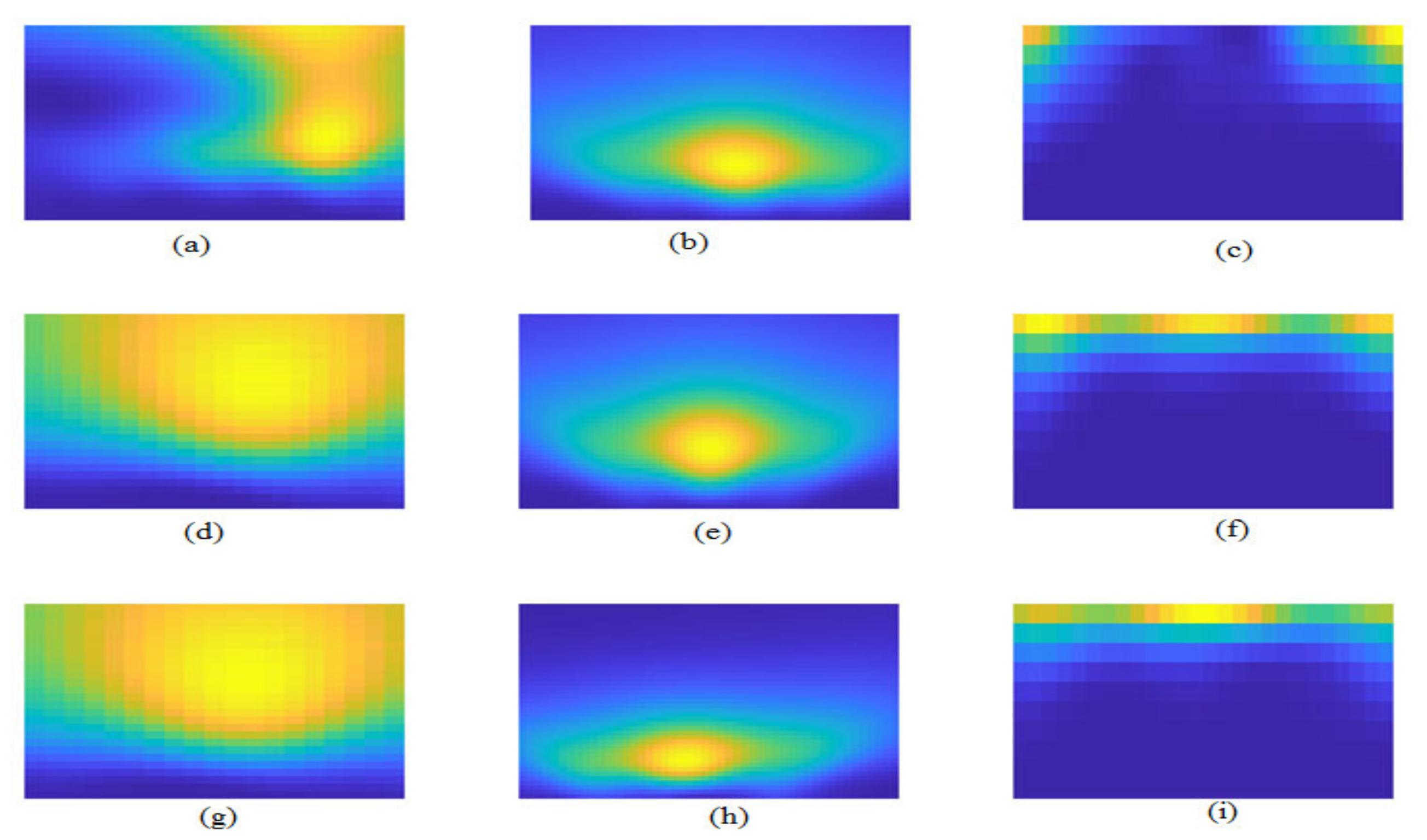

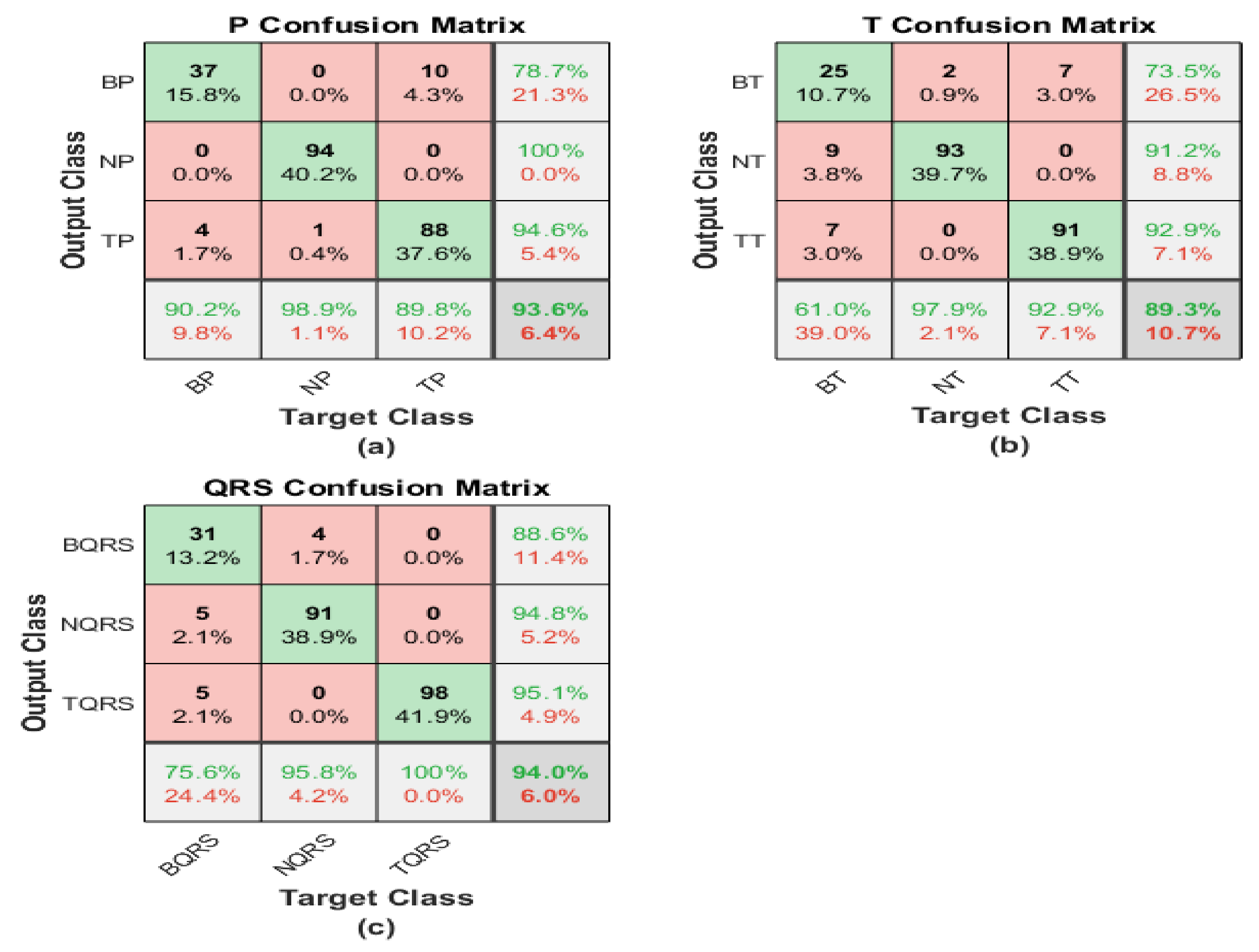



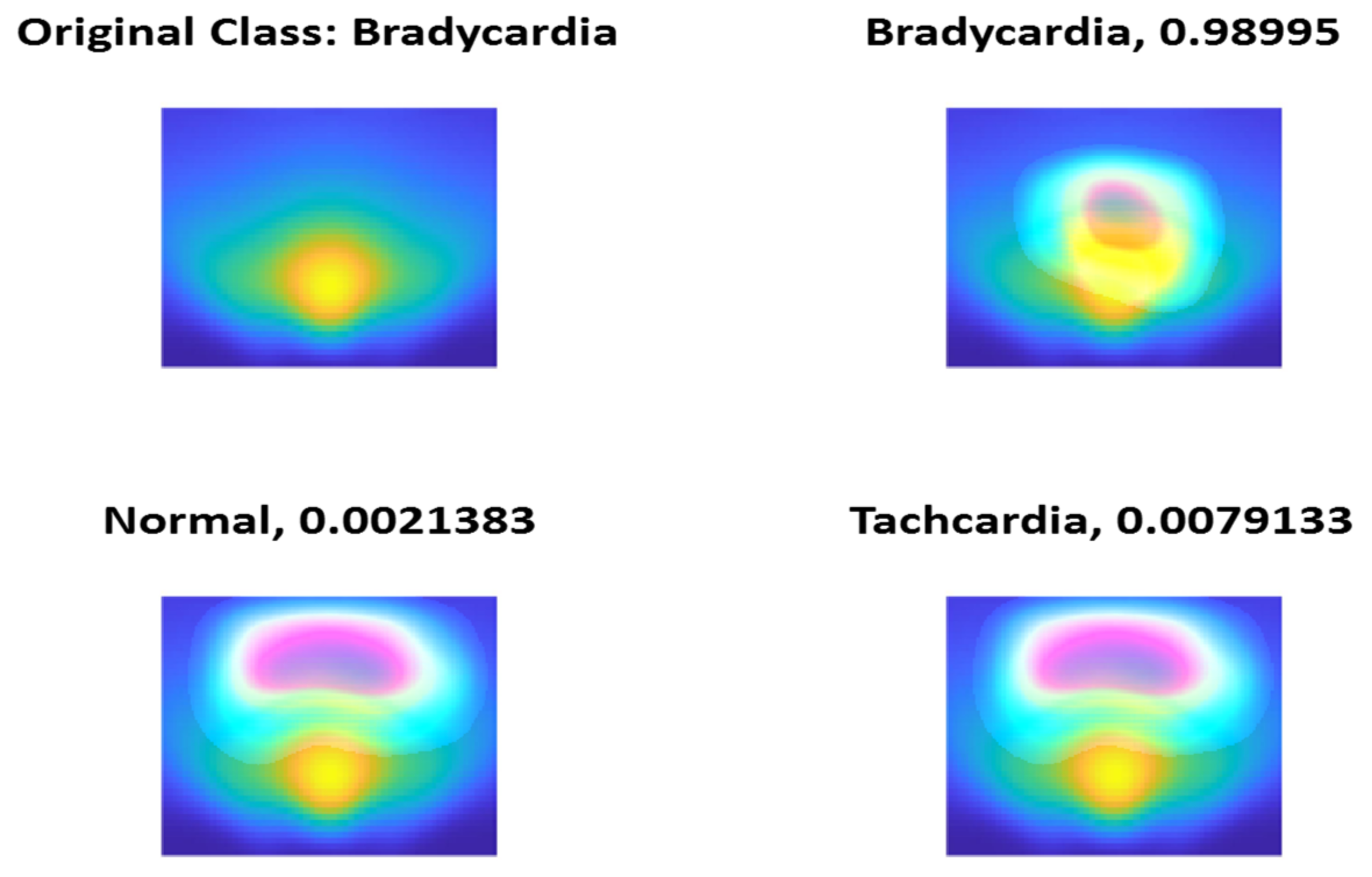
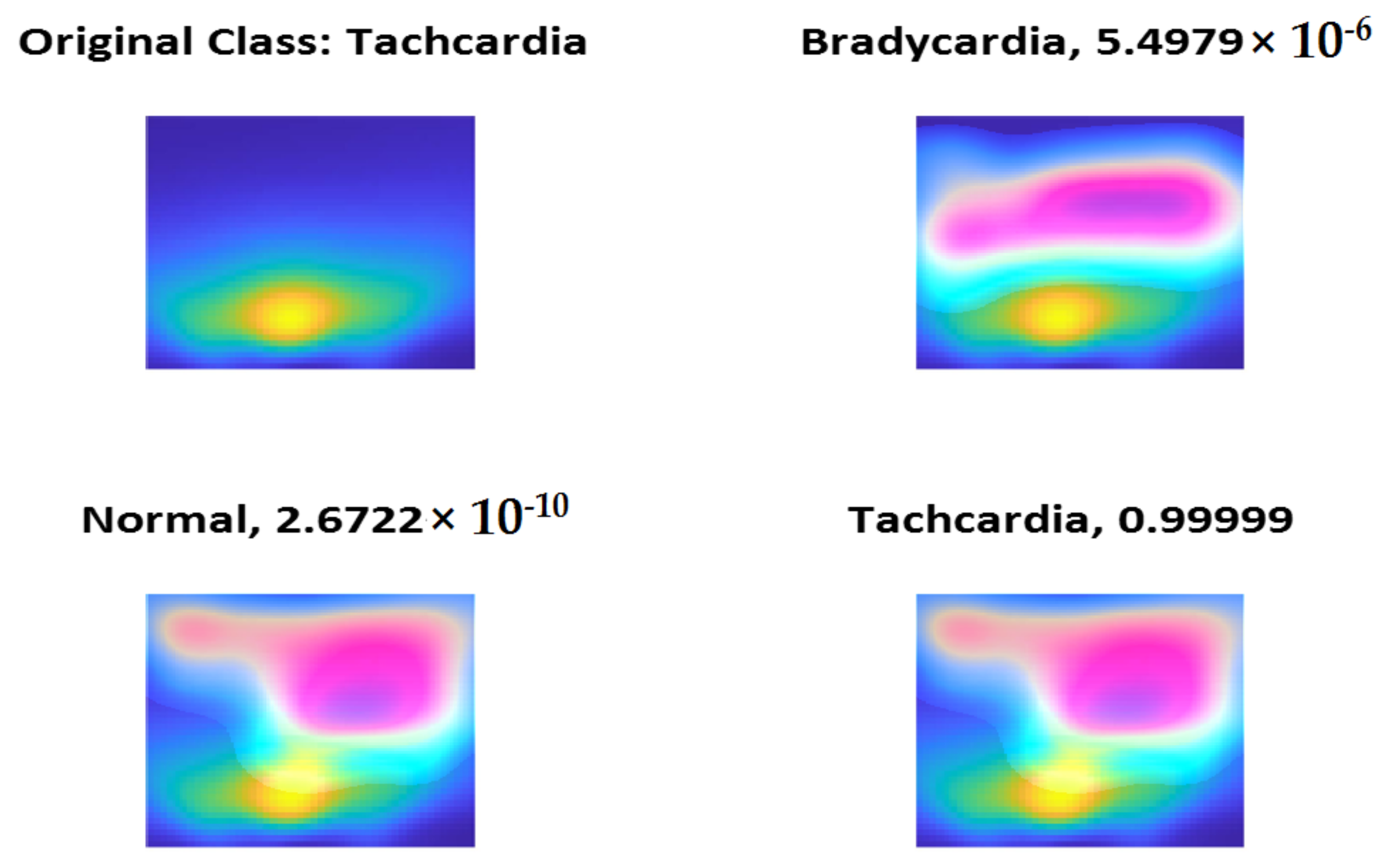
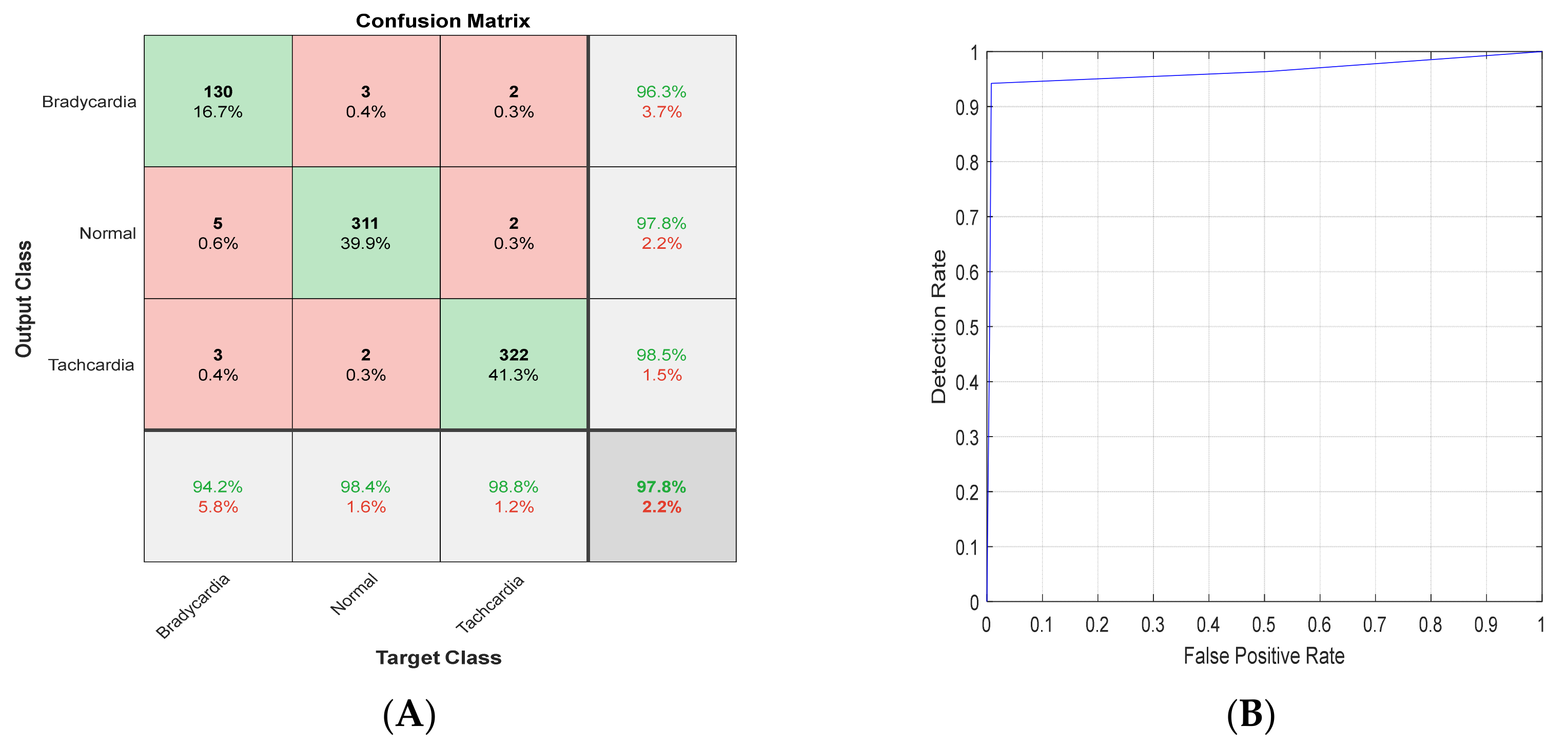

| ECG Waves | Amplitude | Frequency |
|---|---|---|
| P-Wave | 0.25 mV | 5–30 Hz |
| QRS-Complex | The amplitude for the largest wave R is 1.6 mV | 8–50 Hz |
| T-Wave | 0.1–0.5 mV | 0–10 Hz |
| P-Wave | QRS-Wave | T-Wave | ||||
|---|---|---|---|---|---|---|
| Sensitivity | Precision | Sensitivity | Precision | Sensitivity | Precision | |
| Bradycardia | 85.40% | 94% | 90% | 86% | 39% | 57.10% |
| Normal | 91.60% | 98.90% | 96.80% | 96.80% | 90.50% | 92.50% |
| Tachycardia | 96.90% | 87.20% | 94.90% | 96.40% | 95.90% | 83.20% |
| Accuracy = 92.7% | Accuracy = 94.9% | Accuracy = 83.8% | ||||
| P-Wave | QRS-Wave | T-Wave | ||||
|---|---|---|---|---|---|---|
| Sensitivity | Precision | Sensitivity | Precision | Sensitivity | Precision | |
| Bradycardia | 90.20% | 79% | 76% | 89% | 61% | 73.50% |
| Normal | 98.90% | 100.00% | 95.80% | 94.80% | 97.90% | 91.20% |
| Tachycardia | 89.80% | 94.60% | 100.00% | 95.10% | 92.90% | 92.90% |
| Accuracy = 93.6 | Accuracy = 94 | Accuracy = 89.3 | ||||
| P-Wave | QRS-Wave | T-Wave | ||||
|---|---|---|---|---|---|---|
| Sensitivity | Precision | Sensitivity | Precision | Sensitivity | Precision | |
| Bradycardia | 85.40% | 88% | 44% | 49% | 95% | 95.10% |
| Normal | 97.90% | 100.00% | 94.70% | 92.80% | 97.90% | 100.00% |
| Tachycardia | 94.90% | 92.10% | 83.70% | 82.00% | 100.00% | 96.00% |
| Accuracy = 94.4% | Accuracy = 81.2% | Accuracy = 98.3% | ||||
| P-Wave | QRS-Wave | T-Wave | ||||
|---|---|---|---|---|---|---|
| Sensitivity | Precision | Sensitivity | Precision | Sensitivity | Precision | |
| Bradycardia | 2.40% | 14% | 88% | 90% | 20% | 38.10% |
| Normal | 84.20% | 84.90% | 96.80% | 100.00% | 86.50% | 97.60% |
| Tachycardia | 91.80% | 65.20% | 99.00% | 95.10% | 93.90% | 71.30% |
| Accuracy = 73.1% | Accuracy = 96.2% | Accuracy = 77.8% | ||||
| T-Wave with ResNet101 | QRS-Wave with ShuffleNet | |
|---|---|---|
| Sensitivity | 97.13 ± 0.95% | 97.29 ± 1.30% |
| Precision | 97.52 ± 0.23% | 96.11 ± 0.17% |
| Accuracy | 97.82 ± 0.65% | 97.31 ± 0.50% |
Disclaimer/Publisher’s Note: The statements, opinions and data contained in all publications are solely those of the individual author(s) and contributor(s) and not of MDPI and/or the editor(s). MDPI and/or the editor(s) disclaim responsibility for any injury to people or property resulting from any ideas, methods, instructions or products referred to in the content. |
© 2023 by the authors. Licensee MDPI, Basel, Switzerland. This article is an open access article distributed under the terms and conditions of the Creative Commons Attribution (CC BY) license (https://creativecommons.org/licenses/by/4.0/).
Share and Cite
Zyout, A.; Alquran, H.; Mustafa, W.A.; Alqudah, A.M. Advanced Time-Frequency Methods for ECG Waves Recognition. Diagnostics 2023, 13, 308. https://doi.org/10.3390/diagnostics13020308
Zyout A, Alquran H, Mustafa WA, Alqudah AM. Advanced Time-Frequency Methods for ECG Waves Recognition. Diagnostics. 2023; 13(2):308. https://doi.org/10.3390/diagnostics13020308
Chicago/Turabian StyleZyout, Ala’a, Hiam Alquran, Wan Azani Mustafa, and Ali Mohammad Alqudah. 2023. "Advanced Time-Frequency Methods for ECG Waves Recognition" Diagnostics 13, no. 2: 308. https://doi.org/10.3390/diagnostics13020308
APA StyleZyout, A., Alquran, H., Mustafa, W. A., & Alqudah, A. M. (2023). Advanced Time-Frequency Methods for ECG Waves Recognition. Diagnostics, 13(2), 308. https://doi.org/10.3390/diagnostics13020308








